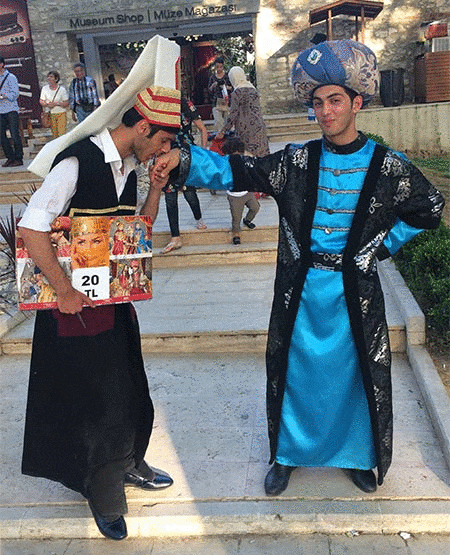
Turkish/Israeli Delights
I waded anxiously into a sea of travelers who were slogging their way to passport control at The Ataturk International Airport in Istanbul.
I clutched at my American passport and Turkish Visa as the crowd control barriers squeezed us into a single line. Upon reaching its front, I saw customs officials stationed in kiosks and approached one who was free.
He asked me the usual questions, “Where are you going? How long will you be there?”
I said I was the webmaster of the 42nd IEEE International Conference on Plasma Science (ICOPS) in Antalya, Turkey that would take place May 24-29, 2015. I told him I would be sightseeing in Istanbul for a few days before heading out to the conference. He rubber-stamped a page in my passport and motioned me to move on.
I walked into the atrium of the airport and came upon dozens of cab drivers, standing in a long line, holding pieces of A4 paper that displayed their rider’s name. I walked up and down the line a few times until I saw my name, neatly printed (and correctly spelled, for once) in bold capital letters.
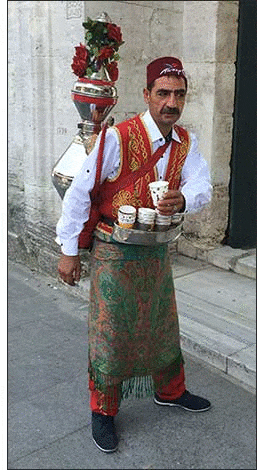 The SiDE Hotel had sent the driver, and I felt sorry for him because my plane arrived an hour late. He helped me find an ATM where I withdrew 200 Turkish Lira (70 dollars). Then he loaded my luggage into a spacious van and let me sit in the passenger-side front seat.
The SiDE Hotel had sent the driver, and I felt sorry for him because my plane arrived an hour late. He helped me find an ATM where I withdrew 200 Turkish Lira (70 dollars). Then he loaded my luggage into a spacious van and let me sit in the passenger-side front seat.
The ride from the airport to the historic district of Istanbul covered 12 miles and cost me 30 euros ($33). I didn’t mind paying that steep fare becauseI had the van all to myself.
I guess I could have taken the city’s clean commuter train for only a couple Turkish Lira, but I was shlepping luggage and was feeling unnerved by this bustling metropolis of 14 million people, Europe’s largest city.
The driver tried to explain to me that he had the same name as one of Turkey’s greatest architects, Mimar Sinan. This conversation never really went anywhere because my Turkish was as bad as his English. So I sat quietly for most of the ride, marveling at the homely faces of political candidates plastered on posters as far as the eye could see.
The no-nonsense, yet charming Turkish Airlines flight attendants took excellent care of me during my grueling 12-hour coach flight from Houston to Istanbul. They served me a tasty, though frugal supper, treated me to my first “Turkish Delight” soft candy and gave me a hot towel afterward to freshen my face. My only complaint was that they cut me off after my second free can of Efes, Turkey’s tasty national beer.
The touchscreen monitor in front of my coach seat linked me to first-run Hollywood movies and a wealth of exciting Turkish jazz and rock-and-roll music. The plane, a spacious 737, had a large bathroom that was kept immaculate.
Turkey is the world’s 16th largest country with a population of 82 million. It is the size of Texas has eight neighbors including Syria, Iraq, and Iran. My family and friends were concerned about me traveling to the region, but my boss, Dr. Edl Schamiloglu, assured me there was nothing to worry about because Istanbul and Antalya were safer than Albuquerque (which did little to reassure me).
As conference webmaster, I did my best to win the confidence of our wary International audience of professional engineers, but it was like walking a tightrope. I had to remove the words “Syria” and “Iraq” from the map on our website so it wouldn’t alarm people. And I didn’t put photographs of girls in bikinis by the seashore on the conference website because I didn’t want to offend any of our Muslim friends.
Turkey is a moderate Arab country. The kids love their rock and roll and dress stylishly. The drinking age is 18, three years younger than the United States. There are 3,200 mosques, 400 churches, and ten synagogues. Overall, the government takes pride in being more secular than its Arab neighbors, but unfortunately, its leaders don’t seem to embrace freedom of the press like we do in America.
The SiDE hotel was in the Sultanahmet district, a stone’s throw away from just about every famous building and museum that I would visit in the next few days. My room was on a third-floor walk-up, with a balcony, a private bath, TV and cold air conditioner, all for 60 euros ($67) a night; pretty reasonable if you consider that the Four Seasons, just a block away, was selling rooms for over $300/night.
The SiDE’s internet connection was slow and unreliable, and that was a problem because the Skype app and Facetime on my iPhone needed a reliable wi-fi signal to work.
Cricket is my cell phone provider and its service stopped working after I left the United States. To be honest, it was a relief to be off the grid.
After I settled into my spotless room at the SiDE Hotel I spent the next couple hours visiting the nearby Blue Mosque. Evening prayers closed its interior to tourists, but I was able to walk freely around its massive stone courtyard, chat with people and take pictures of those cool minarets.
One fellow, neatly dressed in a crisp, white, button-down shirt, offered to show me around Istanbul in exchange for me visiting his rug shop.
I had recently read Paul Theroux’s The Pillars of Hercules: A Grand Tour of the Mediterranean where I learned about this time-wasting and self-serving tactic to sell rugs, so I thanked him for his kind offer but respectfully declined. He persisted, but finally grew tired and moved on to bothering somebody else.
Meanwhile, some older men began shooting mega-powerful laser beams at the Minarets, using portable, hand-held devices. They illuminated them with enormous neon green splotches that spasmodically traveled up and down the length of those ancient, magnificent structures.
I wondered if this might be blasphemous and was tempted to say something, but wisely refrained because I didn’t want trouble.
There is a lot of commerce going on around those Turkish landmarks, and even the beggars get in on the action. One timeworn lady, decked in black robes, had a highly desirable piece of real estate staked out near one of the entrances to the mosque’s courtyard. I dropped a one-lira coin (34 cents) in her cup on the way out and she blessed me in Arabic.
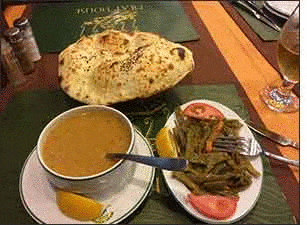 The highlight of my evening was the discovery of a restaurant just around the corner from my hotel called the Meat Shop. The vegetarian and meat-packed menu had something for everybody. Thousands of photographs covered the walls whose entire storefront was wide open to the street.
The highlight of my evening was the discovery of a restaurant just around the corner from my hotel called the Meat Shop. The vegetarian and meat-packed menu had something for everybody. Thousands of photographs covered the walls whose entire storefront was wide open to the street.
I ordered lentil soup and a big salad that came with a curious, fresh-baked bread that was thin crusted and big as a football. I also ordered a pint of Efes draft beer, and the bill came to less than $10.
Best of all, the restaurant had free wi-fi with a super strong connection that allowed me to make Skype and Facetime calls to family and friends in America.
Then it was off to bed.
I was wise to have chosen the SiDE Hotel. The neighborhood streets were super clean, and I found the design of its brickwork to be exquisite.
As night fell, an eerie silence overtook the historic district, broken only by the cries of seagulls, the barking of dogs and an occasional cat fight.
I managed to get a good five hours of sleep that night and would have gotten more but was woken up at 4:30 the next morning by the call for prayers.
Sung by the muezzin, his haunting voice projected from speakers mounted on minarets scattered throughout the city. Those tall, slender towers helped to create a stunning skyline as they broadcast the three-minute call to prayer in Arabic, five times a day.
The muezzin sings a capella and his voice echoes through the nooks and crannies of the old city. His voice silences all those noisy dogs, fighting cats, and seagulls for a while.
When the call to prayer was over, I heard it repeated at another mosque, in a distant part of the city.
The SiDE Hotel provided a Spartan though surprisingly satisfying breakfast for its lodgers. I dined on its rooftop at a table that had a stunning view of the Ayasofya Museum. The meal consisted of olives, cheese, some tomato slices, a hard boiled egg and plenty of stale dinner rolls.
At breakfast that morning I met Greg and Ann, Australian tourists who were preparing to leave town for the next leg of their journey. When I told them that I was going to stay three more days at the SiDE, they gave me their detailed map of Istanbul and went to great lengths to mark the places that I simply had to see.
Greg gave me his commuter pass which would allow me to board all the city bus, trams, and streetcars. The pass had nine more dollars in it, which turned out to be an excellent way to kick start my adventures.
Having visited and been turned back from entering the Blue Mosque the night before, I gave it another shot but was turned away yet again. There was some significant religious event going on and only the faithful could enter.
After milling around the grounds of the Blue Mosque I walked to the street and was accosted by a wandering Turkish rug salesperson who began chatting me up.
I politely explained to him that my house was too small for a carpet and that, in any case, I did not want one. He wouldn’t take no for an answer and finally got me to visit his shop where its owner served me sweet apple tea while his workers rolled out many beautiful rugs, one after the other and somewhat dramatically, on the floor for me to inspect.
Using an oversized photograph mounted on poster board and propped on a wooden easel, the owner taught me about the intricate knots that make up a good Turkish rug.
Apparently, I was getting into this over my head and tried to make it clear to him that I really and truly did not want a rug, even if they were to give it to me for free.
After narrowly escaping the clutches of those persistent rug merchants, I made a beeline for the Ayasofya Museum and joined a long, snaking line of people who were as eager as myself to experience the place. After waiting in line for half an hour I bought an entry ticket for 30 Turkish Lyra ($10), crossed through a metal detector and entered the grounds.
As I passed through the ancient former mosque’s interior, my shoes fell naturally into the footprints left by the millions of people who had preceded me. The marble also showed erosion at the thresholds of doorways where countless visitors had come and gone.
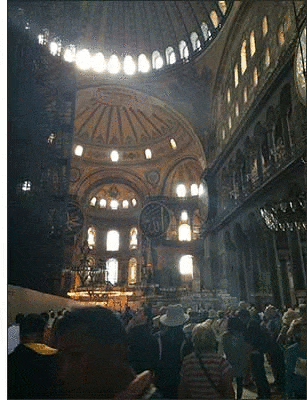 I felt dwarfed by Ayasofya’s vast open space, its massive walls and towering, ornate columns. Although I was just one of hundreds that surrounded me, I did not feel claustrophobic. It was still early in the morning and it would take the presence of thousands more before I would feel the least bit cramped.
I felt dwarfed by Ayasofya’s vast open space, its massive walls and towering, ornate columns. Although I was just one of hundreds that surrounded me, I did not feel claustrophobic. It was still early in the morning and it would take the presence of thousands more before I would feel the least bit cramped.
As I moved through the building I was drawn to an inclined passage on the side of the building that connected to its upper level. The sloping floor consisted of intricately laid smooth rocks that played with the sunlight.
So beautiful was this passageway that I made a point of revisiting it a couple of times before I left the museum.
A Turkish friend named Oguz later explained the history of that exquisite passageway to me in an e-mail, “Did you know that those sloping ways in Ayasofya were converted from stairs because one of the emperors did not want his sick old wife to feel hurt while she was being carried for Sunday ceremonies in the church? That is love,” he said.
I ascended to the second level where my eyes feasted on the sight of exquisite Christian mosaics. I was also captivated by the hypnotic spider web of cracks in the marble floor beneath my feet.
I spent a couple of hours exploring that old mosque and then left because the crowds just kept getting bigger and I was starting to feel cramped. It was a good thing I arrived early.
After exiting this old mosque I somehow got involved with yet another rug salesperson who insisted that I visit the Y-Not Shop, located in a quiet part of the historic district. It was difficult, almost impossible to resist his advances because, well, if you must know, I have a difficult time saying “no” to people who are nice to me, especially when I’m traveling.
There’s also something about me that enjoys watching a good sales pitch even if I have no intention of buying.
Upon my arrival at the Y-Not Shop, I was treated to Turkish coffee and introduced to the family, who seemed so hopeful that I would buy something. Once they finally realized that I was not interested in buying anything, they stopped being my best friend and dropped me like a hot potato.
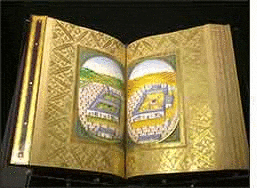 But I found myself in an interesting part of town now and decided to visit the Museum of Turkish and Islamic Art. There I was exposed to many beautiful examples of calligraphic manuscripts: ancient texts of the Koran with intricate, elaborate bindings.
But I found myself in an interesting part of town now and decided to visit the Museum of Turkish and Islamic Art. There I was exposed to many beautiful examples of calligraphic manuscripts: ancient texts of the Koran with intricate, elaborate bindings.
After exploring the museum, I found a money machine where I withdrew 600 Turkish Lira — enough to pay my three-day hotel bill of 180 euros (200 American dollars).
I was surprised that the manager of the hotel insisted I pay him with cash, and he wasn’t particular how it arrived.
“Money is money,” he said coolly. “Liras, dollars, euros, it’s all the same to me.”
So, I was carrying around a big wad of Turkish Lira in my bulging wallet and didn’t feel comfortable about that. I needed to tuck it away in one of the many secret hiding places strapped to my body, and I needed to get away from the hoards of people that were surrounding me.
I found the privacy I craved at 1001 Direk Sarnici, the oldest Cistern in Istanbul. I am not talking about the Basilica Cistern. I had passed that earlier, on my way to the Ayasofya and had no desire to join the long line of people who were waiting to enter. The line to the Blue Mosque was now well over half a mile long, but this little cistern wasn’t attracting a soul.
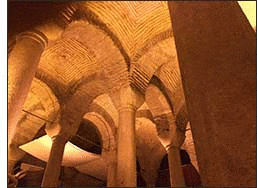 The 1001 Direk Sarnici cistern had no line at all and clearly was never going to get any lines. It was one of those tourist attractions which didn’t quite work out the way its planners had hoped. Nobody except a few curious, lost travelers like myself were inclined to pay the 10 Turkish Lira ($3.30) admission price to enter this place.
The 1001 Direk Sarnici cistern had no line at all and clearly was never going to get any lines. It was one of those tourist attractions which didn’t quite work out the way its planners had hoped. Nobody except a few curious, lost travelers like myself were inclined to pay the 10 Turkish Lira ($3.30) admission price to enter this place.
I explored every inch of the cistern and found it to be dull. The most interesting thing was an ancient inscription carved in a column that supported the ever-dripping ceiling. Those columns and their crowns made for a pleasant photograph, but that was about it.
They manufactured silk in that ancient, dried-out reservoir at one time. Later, it became a municipal dump. It took seven years, and 7,000 trucks to remove all that garbage.
The cistern was dark and smelled of mold. I pitied anybody who had to work there every day, let alone couples who chose to get married there. Yes, it turns out it was a popular choice among the locals and I can’t imagine a more depressing place to get hitched.
The cistern did have a nice, private bathroom that gave me the time and the opportunity to stash those Turkish Lira notes in all my secret hiding places. Having done that, I was glad to get out of there.
Four cruise ships had landed in Istanbul that morning, increasing Istanbul’s tourist population by 20,000 people who were itching to do some serious sightseeing.
I jumped on one of Istanbul’s sleek, modern, air-conditioned trams that took me from the Sultanahmet station to the Eminonu station, near the Galata Bridge — the take-off point for many sea cruises that explore the Bosphorus Strait.
The Bosphorus Strait runs through Istanbul, connecting the Mediterranean Sea with the Black Sea. It also separates Turkey into two parts, one in Europe and the other in Asia.
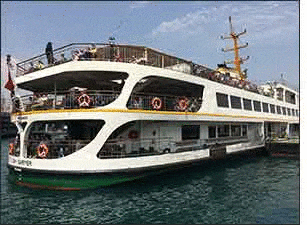 I didn’t want to shell out hundreds of Turkish Lira for a fancy cruise so instead opted for a two-hour hop, skip, and jump that would satisfy my urgent need for fresh sea air. It only set me back 12 Turkish Lira ($4), but the next ferry wouldn’t set sail for two full hours.
I didn’t want to shell out hundreds of Turkish Lira for a fancy cruise so instead opted for a two-hour hop, skip, and jump that would satisfy my urgent need for fresh sea air. It only set me back 12 Turkish Lira ($4), but the next ferry wouldn’t set sail for two full hours.
I spent part of that time exploring a nearby underpass that helped pedestrians get safely from one side of the busy streets to the other.
Traffic lights are something you don’t see very often in Istanbul. Most major intersections use roundabouts to help drivers move from one street to another. Paper maps are useful but don’t figure in the hilly landscapes. But they were better than nothing.
A GPS system on a smartphone would have been the best solution, but I didn’t have a reliable wifi connection, and my cellular service disappeared after I left the USA.
Vendors of all ages were selling selfie sticks (the rage) and toys of every description while the hypnotic strumming of a cura saz echoed against the walls of the underpass. The price of goods always starts high and if you dare to walk away, its price decreases more and more with every step you take.
I walked the length of the Galata Bridge and marveled at the variety of food one can buy, for every budget imaginable. If a waiter wasn’t busy cleaning a table, then he would be hollering at tourists. Once he got your attention he would show you a menu and lure you into his restaurant.
I had to go to the bathroom and wasn’t inclined to pay one Turkish Lira for the privilege of using a public toilet (35 cents). Instead, I enjoyed an eight Turkish Lira ($2.69) fish sandwich and then freshened up in the restaurant’s bathroom for free. The meal was marginally edible, but I could have done without the stale bread, the fish skin and all those friggin bones.
At 2:30 my ship began boarding and I found a comfortable bench on the starboard side. As the ship left port and entered the Strait of Bosphorus, I was overwhelmed by the immense size of Istanbul, its remarkable beauty and the vast number of mosques that filled this city.
And all these mosques had minarets equipped with loudspeakers that broadcast the call to prayer. A muezzin with a good set of lungs could probably do a good job delivering the news or spreading propaganda if the Internet went down.
I grew accustomed to the Arabic call to prayer that filled the air five times a day. It reminded me of how they used to play “Reveille” and “Retreat” at my old Boy Scout Camp. I also got used to the sight of women cloaked in black Abayas and men who washed their feet openly in public sinks before entering a mosque.
It was a perfect day to be cruising. I was wearing a light short-sleeved shirt, along with a long-sleeved travel shirt in case the wind picked up. On the return trip, we passed the Dolmabahce Palace, which I vowed to visit the next day.
This voyage was exactly what the doctor ordered. I always make a point of heading to the nearest water, be it an ocean, lake or river when I’m traveling. The spiritual renewal that I experience when I’m on the water is priceless, even if I’m on a $4 ferry.
Upon my return to the ship’s port by the Galata Bridge I felt refreshed and was ready to take on yet another adventure. I jumped back on a packed, yet comfortably air-conditioned tram that took me over the Galata Bridge to the Karakoy station, detrained and walked up many tiny, cobblestoned streets to the Galata Tower, built in 507 AD.
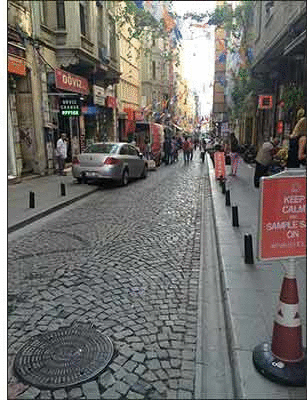 There was a long line but I persevered and, after paying 30 Turkish Lira ($10), I got on an elevator which took me to the seventh floor of that imposing, 200’ tall, 54’ diameter stone structure. From there I carefully ascended two more floors on a narrow, spiral staircase and arrived at the tower’s observation deck where I was able to walk around its entire circumference and get a real feel for the city.
There was a long line but I persevered and, after paying 30 Turkish Lira ($10), I got on an elevator which took me to the seventh floor of that imposing, 200’ tall, 54’ diameter stone structure. From there I carefully ascended two more floors on a narrow, spiral staircase and arrived at the tower’s observation deck where I was able to walk around its entire circumference and get a real feel for the city.
Clearly, there were more than just mosques and rug shops in this bustling metropolis: There were also skyscrapers, shipyards, apartment complexes, residences and so much more, as far as the eye could see. I lingered for a bit, took a selfie and then descended the tower, satisfied with my experience and pleased to scratch another “must-see” off my list.
Next, I set out to visit Istiklal Avenue because it was known as a high-end shopper’s paradise. I managed to find it after making a few wrong turns. Street signs are as rare a sight in Istanbul as are stop lights, but a few bilinguals pointed me in the right direction, and when I finally found Istiklal Avenue, there was no question that I had arrived.
Istiklal Avenue was more than just a shopper’s paradise: This was the place you went when you wanted to be around other people. This pedestrial-friendly street was closed to car traffic and serviced by an antique electrified trolley car.
Istiklal Avenue is cosmopolitan Istanbul at its ritziest: The Michigan Avenue of Istanbul, no doubt — a Gold Coast without the waterfront. Just pure, high-end capitalism that has run amok, with plenty of street musicians and inspiring people milling around.
After walking a good length of the avenue, I jumped on the rustic trolley car and returned to its starting place, then walked back to the Galata Tower. I descended the hill, jumped on a blessedly air-conditioned tram and got back to the SiDE Hotel well before the sun set.
I was hungry and ready for a good dinner, so I decided to head back to the Meat House, which had become my favorite place to eat. You can call me a creature of habit, but Lord, I dearly loved that place.
My last day in Istanbul was a whirlwind marathon that began early at the Blue Mosque. You’ve got to get there early because the lines can go on forever.
I got into the mosque quickly, thanks to a local native named Ramadan. He gave me a tour and promised — Ramadan swore — that he was showing me around out of the goodness of his heart. He was so sincere in his intentions that he refused to accept money from me in exchange for his trouble, BUT insisted, at the very last minute, that I visit his family’s rug shop after we exited the mosque.
What’s a guy to do? I was clearly indebted to him for helping me finally “do” the Blue Mosque after two previous failures. So I followed him to his family rug shop and ended up, much to my chagrin and the owner’s embarrassment at the Y-Not Shop again! There I was treated to some tea and had to, once more, go through the painful process of telling the exasperated owner that I didn’t want a beautiful scarf for $100 or even $50.
“How much will you pay for this scarf?” asked the owner, who had nicknamed me The Paranoid American.
“Look,” I said. “I’ll give you $20 for it.”
He took that offer as an insult while Ramadan sheepishly ducked into the basement without even saying goodbye to me. I began to feel awkward and even a little bit scared, wished them all a good day and got the hell out of there.
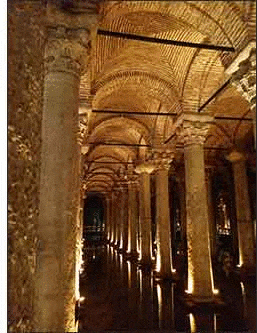 I then visited the Basilica Cistern, which made the other cistern look pathetic. There I saw 105,000 square foot matrices of flawlessly aligned columns partially submerged in a pool of crystal clear water. I followed a concrete boardwalk through scores of perfectly aligned supporting pillars and ended in a far corner of the cistern where I came face-to-face with two gigantic, elegantly carved Medusas that took my breath away.
I then visited the Basilica Cistern, which made the other cistern look pathetic. There I saw 105,000 square foot matrices of flawlessly aligned columns partially submerged in a pool of crystal clear water. I followed a concrete boardwalk through scores of perfectly aligned supporting pillars and ended in a far corner of the cistern where I came face-to-face with two gigantic, elegantly carved Medusas that took my breath away.
I continued my whirlwind final day in Istanbul with visits to the last items on my to-do list. That included visiting the glamorous 110,000-square-meter Dolmabahce Palace, built in the 19th century, which wowed me with its crystal staircase (much like a solar oven during the summer months) and magnificent ceremonial hall.
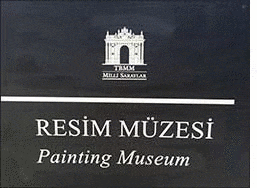 Next door to the Palace was “The Painting Museum” whose no-nonsense name and Spartan bathroom (basically a hole in the floor) also made for a memorable visit.
Next came the Topkapi Palace and Museum where I saw chivalric coats of armor from the Ottoman Empire and a well-guarded room filled with display cases containing large, sparkling diamonds and rubies.
Next door to the Palace was “The Painting Museum” whose no-nonsense name and Spartan bathroom (basically a hole in the floor) also made for a memorable visit.
Next came the Topkapi Palace and Museum where I saw chivalric coats of armor from the Ottoman Empire and a well-guarded room filled with display cases containing large, sparkling diamonds and rubies.
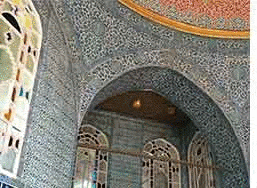 I was overwhelmed by the beautiful blue-and-white or yellow-and-green tiles that graced the walls of the offices, chambers, and apartments located at the back of palace grounds. I’m no fan of the practice, but I found the “Circumcision Room,” built by Sultan Ibrahim in 1640 to be one of the most beautiful pieces of architecture I’ve ever seen.
I was overwhelmed by the beautiful blue-and-white or yellow-and-green tiles that graced the walls of the offices, chambers, and apartments located at the back of palace grounds. I’m no fan of the practice, but I found the “Circumcision Room,” built by Sultan Ibrahim in 1640 to be one of the most beautiful pieces of architecture I’ve ever seen.
The Grand Bazar was next on my list but, once having walked through its iconic arched stone entryway, I could barely wait to get out. The place made me feel claustrophobic, and it also confirmed my gut feeling that Istanbul was one of the most capitalistic centers on earth: If you like to shop, this is the place to be.
You can find just about anything you want in Turkey — except for free speech. Political dissent is frowned upon, as is pornography. Straight porn is out there, but it comes off as a vehicle for selling fake Viagra.
On the way back to the hotel I visited the Schuliman Mosque, which, they say, is one of the loveliest mosques of all. But, as the docent told me, “If you’ve seen one mosque you’ve seen them all,” and there may have been some truth to that.
She said the mosque’s vast interior space used to be illuminated by candles, and their smoke exited the building through an upstairs room. The soot on its walls was periodically scraped and made into ink for their religious manuscripts.
The Schuliman Mosque was certainly beautiful but what amazed me most were the cemeteries that surrounded it. Endless, sobering rows of intricately carved gravestones mark the passing of generations of Muslims.
As I somberly walked back to the SiDE Hotel, I found myself behind a man who shined shoes. As I approached, a brush popped out from under his arm and landed near my feet.
Most civilized, compassionate people would have picked the brush off the ground and handed it back, but I just coldly walked passed him. Then I looked back and saw him quickly retrieve his brush and try this scam on somebody else.
Edl warned us about this trick before we left the states. He sent our team a YouTube link that showed us what to expect, and he was exactly right on the money:
Here’s how it works: Once you give the shoeshine guy back the brush he will tell you all about his troubles and become your new best friend, all the while waiting for the opportunity to separate you from your money. At least, that’s the picture Edl drew for us, and he should know because he had once fallen victim to this scheme.
My last supper in Istanbul was at the usual eating place and, as I was sampling something new from the menu, I looked out into the street and saw a crowd of well-dressed men being chased down the street by a battalion of uniformed police with shields and batons.
The manager told me that the police had rounded up all those rug salesmen who hang around the mosques. I smiled to myself and wondered if my old pal Ramadan from the Y-Not Shop was among them.
After a most satisfying meal, I went to bed, having “done” Istanbul as well as possible, in the short time I was there.
It cost me 15 Turkish Lira ($5) to get from the SiDE hotel back to the Ataturk Airport the next morning, squashed in a van with 12 other people. I marveled at the way the driver was able to negotiate the steep, narrow cobblestone streets with ease.
We barely made it to the airport in time, and then the driver insisted I get out of the van at the International terminal, assuming I was going to leave the country. He argued with me and refused to take me to the domestic terminal; then he had the audacity to drag his curbside buddies into the fray to somehow defend his case.
And even though I showed the driver my domestic ticket to Antalya, he insisted I was wrong. I got upset, gave the driver a Turkish Lira tip (35 cents), grabbed my luggage and schlepped it a good half mile to the domestic terminal.
When I reached the Domestic Terminal I was confronted with a level of security that I had never, ever encountered at an airport before. Three layers, to be exact, and each layer was intense. There was a security checkpoint at the very entrance to the airport. There was another security point when you entered the food court (right before you head out to the gates) and there was yet another security checkpoint at the gate itself.
By now I had become well-accustomed to stripping down to my underwear to get quickly through the metal detectors. The fact that the plane was going to take off within an hour of my arrival at the airport made me frantic, and I broke out in a heavy sweat under the torrid heat of the afternoon sun.
Fortunately, my new $140 travel vest came to the rescue, and I threw my belt, my cellphone, wallet, and anything else that would trigger an alarm, into one of the 22 pockets of the vest and tossed it all into the X-ray machine.
When I arrived at my departure gate I was psychologically and physically drained . . . And I felt like a lost sheep.
“Can I buy you a beer?” called out my boss, Edl, when he saw me.
Edl, his family, and a few of his graduate students were hanging out in a restaurant by the second security checkpoint. As promised, they had just arrived in Istanbul from The States and were prepared to catch their connecting flight to Antalya — and the ICOPS conference.
I was never so glad to see “the boss,” and that ice-cold Efes went down well.
It’s 538 miles, or about one hour travel time, to get from Istanbul to Antalya. I was flying coach, but even so, I was served a delicious and filling free meal.
Lunch arrived in a neat box with a string handle. Eggplant salad, cheese and turkey sandwich, chocolate banana mousse, and a fresh olive: All fresh ingredients and no chemical preservatives, prepared on that very same day.
When was the last time you were graciously served a delicious meal on a 500-mile flight in coach?
The Cornelia Diamond Resort is one of Turkey’s many such exclusive, high-end resorts, all built in a row, along the Mediterranean coastline.
Our group — the conference organizers and their families — were met at the Antalya Airport by a VIP van that whisked us to the resort. The airport van passed through a heavily-guarded security checkpoint, followed by a wooded area, finally arriving at a massive, sprawling compound.
I entered a sun-drenched, blessedly air-conditioned modern atrium and registered at the front desk. The clerk studied my paperwork then handed me my electronic room key, maps of the compound and schedules for the upcoming Broadway meals and shows.
I arrived at my suite through a long maze of carpeted and windowed corridors that bewildered me at first but soon became familiar. I had the run of the place, and everything was free: The meals, the alcoholic drinks, the saunas, the whirlpools, the entertainment. The housekeepers restocked my refrigerator every morning and no one kept track of anything I consumed.
Imagine a sort of Venetian layout with the suites facing tiled canals filled with clear, warm water. Those channels meandered throughout the compound, eventually meeting up with even larger bodies of water.
Concrete pathways ran through intricately planted fields of ivy greenery. Then these pedestrian trails launched themselves into the open air and gained easy access to the Mediterranean AND its pristine beaches, water slide, and wooden pier. Well-cushioned, adjustable lounge chairs were neatly lined up on the boardwalk, beckoning me.
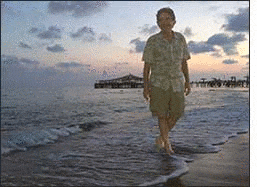 My responsibilities for the next few days were relatively light. I had been well-indoctrinated into the mysteries of conference organization many times in the past, and I performed my duties efficiently and with confidence. By now in my career, I could do this stuff in my sleep.
My responsibilities for the next few days were relatively light. I had been well-indoctrinated into the mysteries of conference organization many times in the past, and I performed my duties efficiently and with confidence. By now in my career, I could do this stuff in my sleep.
So the days of the conference flew by quickly and although I was bored by most of the proceedings, I took pride in the fact that all these stodgy scientists seemed to be having one helluva good time.
Once I had completed my daily chores I wasted no time finding my favorite steam room or sauna. While there, I might recognize the wife, son or daughter of some conference attendee, and we would enjoy each other’s company in this Turkish paradise.
Since I was not presenting a paper, poster or talk at the conference, I was not expected to be there all the time. Once I completed my duties, Edl would give me the nod and tell me I was free to go; and you better believe I was out of there in a flash to sunbathe on the well-combed beaches of the Mediterranean or swim in its tranquil blue waters.
One of those saunas had a large, rustic bucket of water delicately balanced over its door. After a bit of sweating, I would position myself beneath it, pull a rope and 25 gallons of cold water would fall upon me, all at once. Then the bucket would replenish itself, and I could do it all again.
Freshly-squeezed juices awaited me at the spa’s front desk, and all were free, prepared by cheerful young ladies.
Water slides of varying degrees of steepness held the promise of other forms of free amusement by the beach, and I didn’t give their potential dangers a moment’s thought as I climbed them like a boy and slid down them again and again.
The distinguished professors came out to play after sunset and the daily conference events were over. The resort’s main dance floor was a large peninsula of concrete that jutted into a massive swimming pool. Dancers were kept separate from those who lounged on the sidelines, as they should be.
We had done our day’s work, and now it was time to play! A nearby buffet table catered to our hunger and a free bar quenched our thirst.
A robust sound system pumped out music that got into our bones, and those of us who could dance, and many who thought they could dance, crowded onto the dance floor and let loose.
Much to my shock, amazement and downright envy, it turned out that one of the best dancers at the conference was none other than the chair of my department, Dr. Christos Christodoulou.
Christos could swing, he could jive, he could boogie — oh my god he was good. His face beamed with the most radiant smile as he twirled, turned and danced like Zorba the Greek. He wore out at least six women before he took a break, and then he was up for six more. I was amazed and totally envious.
Even my boss, Dr. Edl Schamiloglu, eventually made it onto the dance floor. He cut a dashing figure with his daughter and his wife who had accompanied him to the conference.
And so, the professors and I made a point of gathering by the dance floor every evening at our special table near the dance island. These distinguished professors respected my simple dance skills as much as they appreciated my web skills — and the walls of academia came crashing down.
Edl treated us conference organizers to a day trip where we visited Aspendos; a magnificent marble Roman Colosseum built between 161 and 180 AD during the reign of my favorite philosopher, Marcus Aurelius.
Aspendos was designed by the architect Zeno, son of Theodorus and is considered the best preserved ancient theater in Asia Minor.
Forty free-standing marble columns and niches for statues decorated the theater’s spectacular, two-story scaenae frons. Aspendos could fit 15,000 people and was said to have such perfect acoustics that you could hear a pin drop.
On the way back to the resort we visited a spectacular example of a multi-arched Roman aqueduct, which was once used to transport water from one place to another.
We also visited the port city of Antalya where we walked along the boardwalk, took in the fresh sea air and watched the ice cream vendors deftly toss around their freshly-made ice cream.
Finally, the banquet night arrived, and a handful of first-class coaches shuttled us to yet another resort where the conference organizers pulled out all the stops: A troop of belly dancers, both men and women, danced for us, and we socialized on a vast lawn by placid waters. Then we were led into a banquet hall where we feasted on hors d’oeuvres, lamb in Tandori, doner kebab, bread pudding, Turkish desserts consumed unlimited alcohol and watched dozens of brilliant people receive awards for their accomplishments.
But all good things must come to an end and so did the conference. It was time to move on, so the next day I flew back to Istanbul.
It was only 700 miles from Istanbul to Tel Aviv, so I figured that the time had finally come for me to visit my extended family in Israel. I hadn’t traveled much during my childhood. I hadn’t been across “the pond” since I was 19 years old and made it as far as the Greek Island of Mykonos before an illness made me reluctantly return home.
Unfortunately, most of the old guard (my mom and dad, aunts and uncles) had all died, and of my blood relations that remained in Israel, none had ever met me.
I had approached Miriam timidly by e-mail a year before the conference. She is the 65-year-old daughter of my mom’s sister who passed away some time ago, and she lives on a kibbutz in northern Israel. Having not much to break the ice, I introduced her to my website at www.chucksville.com.
An answer came almost immediately.
“I’d love to have you here. Come whenever you can and stay for as long as you wish.”
Those words were music to my ears, and I quickly took a liking to my cousin, who was only six years older than me. Miriam was well-read, and we spent a lot of time talking about books in our on-going e-mails. I mentioned to her that I was reading a lot of Mark Twain.
“I loved reading Mark Twain books,” Miriam wrote back. “From what I read about your days in the Boys Scouts, I think you have a little of Huck Finn in you!”
Since I had not been abroad since I was a teen, I was a bit fearful of the unknown, but my cousin helped me confront my fears and surmount them.
For example, she said that when I go for a walk I should just carry a photocopy of my passport and $20 in small bills. “That way you’ll be able to give them something in case you get mugged.”
We exchanged e-mails for a year and we wrote to each other several times a week before I left for my trip. Her words never ceased to amaze me. For example, here’s what she wrote after she received a Valentine’s card from me.
“We have our day of love. It goes all the way back in history: Tu-Beh-Av, the 15th of the month of Av. Everyone wears white, so there is no difference between rich and poor. The unmarried (virgin) girls hide in the vineyards and orchards and the young men go out to seek them and kidnap the one they love — and the rest is up to them. Now it’s more about flowers and chocolate hearts. So there goes another sweet tradition to hell.”
I felt very much at home from the moment I arrived in Tel Aviv. The place looked a lot like New Mexico: arid and semi-mountainous countryside interspersed with patches of green.
Ben Gurion had the feel of a small town airport to me, much like the Albuquerque Sunport.
I found that the architecture of Terminal 1, designed by Moshe Safdie — with its vast open spaces and marble walls — combined to form an excellent first impression of Israel: solid as a rock yet elegant.
I was interviewed by a female Israeli soldier when I arrived at customs. She could not have been more than 18 and was beautiful. She took a genuine delight in the fact that I was visiting a family that I had never met.
After that brief interview, I stood in front of a machine that used facial recognition and high-tech biometrics to compare me to a database of known troublemakers. Within a matter of seconds, the process was over. I had passed with flying colors and had a printed (not stamped) receipt to prove it. (You’ve got to give the Israelis credit for discretion: Nobody has to know you visited their country if you don’t tell them.)
And so, Miriam greeted me in the waiting room of the airport along with her cowboy brother Reuven, both in their mid-60s. They had driven from northern Israel to pick me up, a distance of 90 miles — about one-third the length of the country.
The two-hour drive from the airport to Degania Bet in Northern Israel followed modern highways that cut through the rural countryside and towns. The Arabs lived on one side of the road and the Jews lived on the other. It didn’t take rocket science to figure out which was which. The mosques and their unmistakable minarets pretty much gave that away.
My first impression of Israel was that it was a desert, not unlike New Mexico, but Miriam said the country was full of microclimates that lent to a diverse geography.
True, Israel was arid and desolate in 1948 when it was declared a state but, thanks to the work of environmentalists and scientists, it has evolved into a much more liveable place. Still, from my vantage point, it looked pretty damn dry.
Israel is a tiny country of 8,000 square miles, about the size of New Jersey. It has a population of 8.2 million people and of those, 75 percent are Jewish (6.2 million) and 20 percent are Arab (1.7 million). The remaining 5 percent is made up of various ethnicities.
Israel is one the most educated countries in the world and has the highest standard of living in the Middle East, as well as the highest life expectancies in the world.
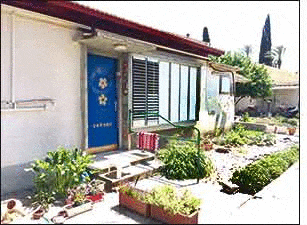 It did not take long before I bonded with my new first cousins. Miriam was a down-to-earth person who didn’t pull her punches, and she didn’t put on airs. She was a most excellent host, stocking practically every inch of her refrigerator with 22 oz. Amber bottles of the best Israeli beer, even though she didn’t drink.
It did not take long before I bonded with my new first cousins. Miriam was a down-to-earth person who didn’t pull her punches, and she didn’t put on airs. She was a most excellent host, stocking practically every inch of her refrigerator with 22 oz. Amber bottles of the best Israeli beer, even though she didn’t drink.
I spent a week living in Miriam’s spare room — the security room, it was called, with its two-foot thick fortified cement walls and steel door. Every house and apartment in Israel had one, and it’s where you go when the bombs start falling.
And, if I just happened to be out and about and all hell breaks loose, I could always duck into one of 30 flower-covered bomb shelters, scattered throughout the kibbutz.
“I find dusting a waste of time,” Miriam said. “I live with all my windows wide open most of the time — summer and winter. I love air. I’ll put fans on outside the windows and front door to send in sweet fresh cooler air from the outside, with dust. Also, Alexis (her cat) and any other cat or dog (not so many people) can wander in for a snack.”
Miriam’s 15-year-old cat, Alexis the Great is “long-haired, three-colored and huge.” She loves that cat and will do anything to keep her happy. “Alexis has been a faithful companion to me. She isn’t well now — some auto-immune thing has attacked her. I give her steroid shots every 15 days, but the time between shots is getting shorter and I will soon have to let the vet put her to sleep. The time is up to me — I will not let her suffer.”
Miriam put green chili on just about everything she ate, and I did my best to keep up with her, which wasn’t easy. I’m from New Mexico, where many of us eat green chili on a daily basis, but Miriam’s appetite for the stuff was like something I had never seen.
Thankfully, that beer she had stocked in her refrigerator for me was the best bottled beer I have ever tasted, so I was happy as a clam. And, although Miriam didn’t cook much, she lived up to her word when she said that I would not go hungry. The kibbutz’s dining hall was only a short distance away by the golf cart she used to get around these days, now that she no longer rode a bike.
“When I think of something yummy it will always be hot spicy, hot and salty,” said Miriam. “When most people here will put jam on their bread, I’ll put “Schoog” — a Yemenite mixture — kind of a salsa — made from hot chili — the more burning, the better — with garlic, cilantro, spiced with cumin, salt, and black pepper. Some add cardamom, but I don’t like that.
“I blend it as fine as I can,” Miriam continued. “I always make it on Friday, usually with around 2 kilos of chili and test taste it with fresh Challa (Shabat bread — the best bread ever!) A nice slice of tomato on top makes it even better. I pack it in 250-gram containers, freeze some, give some to friends (I have a list of “Schoog fans”) and use the rest for myself. It is a beautiful thing in fried eggs or on top of omelets, on bread, on meat, in soup, on top of a plate of hummus with olive oil — just great stuff. Sure beats jam or cake . . . .
“We do have this beautiful little lake — Kinneret — or, as the world calls it, The Sea of Galilee,” said Miriam, changing the subject. “It is surrounded by places where that nice Jewish kid, Jesus, did all kinds of interesting magic tricks. Meaning — this is one holy area for a lot of people. But for me, it is just a beautiful place to live. We are under a peace contract with Jordan to supply them with water — they are in a worse water situation than us — another factor added to draining off the old girl. I have a tropical, tough, drought-tolerant lawn called Kikuyu grass. It’s the envy of every grass-loving person here.”
Much has been written about the Israeli kibbutz but, like all things, it is going through a transformation which is popularly known as “the change.”
“The kibbutz is changing, though Degania Bet is going through the change slower than most kibbutzes. We do pay for a lot of what we get (such as laundry, food, electricity, cars), but we still have a kibbutz life.
“The kibbutz’s cultural activity is still here,” she explained. “Our dining room still serves breakfast and lunch; there is a laundry (usually one of the first things that close in a changed kibbutzim), though now we have to pay for the service. I quit using it as soon as I stopped working there, and so I do my laundry at home. Members of the kibbutz still are subsidized for certain things. The kibbutz still pays for healthcare and education; the gardening is still taken care of — so in all, at least for me, things are fine.”
I felt perfectly content hanging out with Miriam, and I think she felt comfortable being around me. From a spiritual, intellectual, temperamental, artistic and economic standpoint, I felt almost that we were twins.
And there was one thing she said that I could relate to: “We, as a family were never very good at the touchy-feely stuff, and besides a few Seders at home, we never went for the togetherness I’ve seen in other families,” said Miriam.
It was not long before word got around that “Chucky” (as I am known to my family) had arrived, and soon my non-existent schedule began figuring itself out for the next week. I had already met Reuven, and soon I met his ex-wife, Yochi, who was a good friend of Miriam’s.
Also appearing on the scene was my second cousin, Reuven’s 37-year-old daughter, Amira. She arrived at Miriam’s house in a golf cart with all-terrain tires. She brought along her son, an adorable little boy, who showed me a big yellow butterfly that he had been carrying around in a Tupperware container, and which he happily set free.
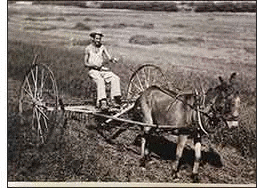 Amira’s English was good, and my Hebrew was bad (nothing beyond hello and thank you), but a smile and a hug were enough to break the ice. We chatted a while and then made serious plans to have some adventures. Since she and her husband are equestrians who actively tour and compete, I figured I was in for a treat.
Amira’s English was good, and my Hebrew was bad (nothing beyond hello and thank you), but a smile and a hug were enough to break the ice. We chatted a while and then made serious plans to have some adventures. Since she and her husband are equestrians who actively tour and compete, I figured I was in for a treat.
Amira’s father, Reuven, also interested me. Not just because he was a cowboy but also because he was a master stone cutter — he could engrave words (Hebrew, English, Arabic) in marble!
May 30, 2015
I drank a “bomber” (how appropriate) of excellent Israeli beer at the northernmost point of Israel today (the Dado Lookout) overlooking Lebanon and Syria. Yochi, Miriam’s ex-sister-in-law, drove us there. Dada is a favorite spot, visited by Arabs and Jews alike who arrive in tour buses to visit what is popularly known as the Golan Heights.
May 31, 2015
Amira introduces me to Rob Roy, a hippy hangout by the Jordan River where we have a cup of tea. The owner, Alon, complains that not many Americans come to visit him.
“Oh,” I say, marveling at the pristine beauty that surrounds me, “my hippy friends would love to know about this place.”
Alon reflected on my words, stared dreamily at the green Jordan River and said, “Do you vant to know how to tell if your house guest is a hippy?” the owner asks me.
“Yes,” I reply, “how?”
“He’s still there!”
Typical Jewish humor.
June 1, 2015
The next day I hung out with Amira at Rob Roy’s, by the muddy banks of the green Jordan River.
Alon, the owner, turned to me.
“What brings you here?” he asked.
“I’d never been to Israel. I have some family here, and I wanted to meet them. I’m not here to sightsee.”
“Are you Jewish?” Alon asked.
“Yes,” I replied in my most paranoid-American tone of voice, “but I’m not that Jewish.”
“Nobody is that Jewish,” he said, with love in his voice. “Welcome home.”
Later, Amira rented a canoe from Alon, and we paddle upstream near the place where the Christians get baptized in their flowing white robes.
“We’re not supposed to be here,” she said to me apprehensively. I sat in the stern of the boat, so I was calling the shots.
“You know,” I told her, “in America, you don’t own the actual water, just the banks of the river.”
“Well, you’re not in America anymore,” my first cousin said pointedly, and I took the hint. So, I turned the boat around and we floated downstream, past brightly colored kingfisher birds, turtles, and two 16-year-old boys in bathing suits who were climbing a tree overlooking the river. They were perfect specimens of youth and vigor.
“Damn,” I told her, lamenting my lost youth. “I wish I had a body like theirs.”
“They’re saying that we’re watching them,” said Amira, translating their Hebrew chatter. “They think we’re tourists.”
We watch them climb higher up the branch. Amira wants to see them fall into the water, which they eventually do and she laughs.
We paddle all the way downstream and have the river entirely to ourselves.
“If we had come tomorrow this river would have been packed. I know the owners and they told me so,” said Amira.
It is a perfect day and it’s lovely to be with my family in this beautiful country. I don’t want to be in Jerusalem. I’ve had enough sightseeing to last me two lifetimes. There’s nothing like hanging out with family.
Later we go out horseback riding. There’s no better way to see Israel than on horseback. Allow me to introduce you to “Kay,” a very friendly six-year-old mare who showed me around the ranch.
“You might find this interesting,” Amira said as she guided me to a bar where a half dozen cowboys were getting ready to collect the semen of a prize quarter horse.
And, although the stallion didn’t have a proper mare to mate, he was definitely in the right mindset for copulating (a good 18 inches, I’d estimate), thanks to all the dedicated ranch hands who had worked hard to get him all sexed up and were eager to collect his seed.
I could try to describe what happens next but I think I’ll take the easy way out and just quote a brief passage from Tom Wolfe’s A Man in Full where he describes, in minute detail, the stallion’s performance in the breeding barn,
....this great poem in motion, this embodiment of power and coordination, to glorious victories on the track—this magnificent engine was reduced to a single jerky, spastic, convulsive, compulsive motion; rut, rut, rut, rut, rut, rut, rut, rut, rut, rut, rut.
That’s pretty much the way it happened and I was impressed.
June 2, 2015
The houses in Israel don’t look a whole lot different than those built in the States except that the walls are cement, and they have fortified safe rooms with two foot thick walls and steel doors—even the most modest abodes.
There’s always a bomb shelter nearby if you happen to be out and about.
Later that day
As I write these words the air is filled with sirens that warn of an attack. It’s the “everyone’s trying to kill us drill,” (as Miriam calls it) and it happens from time-to-time in various communities. But this one is a national event: The whole country is hunkering down right now.
I’m sitting in the kitchen of my cousin’s little concrete-walled home, leafing through a thick, bound, black-and-white photo book that documents the history of this kibbutz that was created by a bunch of settlers back in 1920.
The first people to live here came as pioneers, much like our ancestors in the U.S. arrived in the places we now call home. It’s a fascinating history and I know I will look back at my time in Israel with a longing to return. The wildlife alone beckons. I’d never seen a hedgehog before and they seem quite comfortable here.
The sirens have ceased now, and I take this opportunity to release a butterfly (that hatched just last night) in the hope that someday — somehow —everybody in this world may live in peace.
As my story comes to a close I’d like to thank my new Israeli family for taking such excellent care of me during my stay in Israel. I wasn’t bored for a second and, although I offered to pay my way, they wouldn’t let me pay for anything, including my taxi ride back to the airport in Tel Aviv.
The whole Israeli side-trip fell into place so perfectly. I guess there are times when it’s better to let the chips fall where they may than to try to control fate, especially when you’re traveling and at the mercy of others.
As I was flying back to the states, an e-mail popped into my inbox. It was from Amira and she wrote:
hi dear.
please keep writing me.
its make me happy
my speling is bad so i will not write a lot.
im so happy u had a good time and i cant wait for u to come again.
thank u for coming to israel.
thank you for coming to my house and to our life.
Amira
Thank you for visiting Chucksville. Please sign my guestbook.
Google search is simple: just type whatever comes to mind in the search box below and hit ENTER or click on the Google Search button. Google will then search the entire chucksville.com website for pages or documents that are relevant to your query!
|
|


